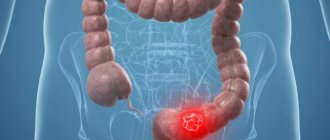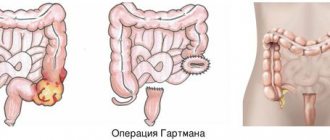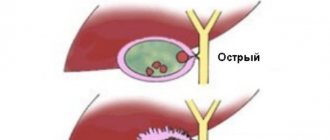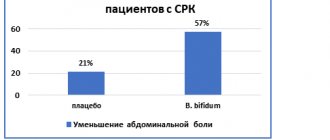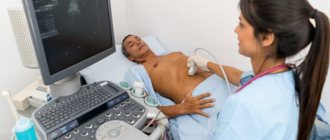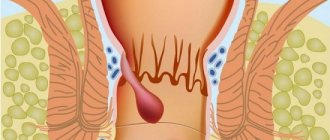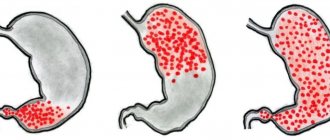Abdominal pain syndrome: etiology, pathogenesis and treatment issues
According to the mechanism of occurrence of pain in the abdominal cavity, they are divided into visceral, paristal (somatic), reflected (radiating) and psychogenic
What are the causes of abdominal pain syndrome? What is the treatment for abdominal pain syndrome?
Abdominal pain syndrome is the leading clinical symptom for most diseases of the digestive system. Pain is a spontaneous subjective sensation that occurs as a result of pathological impulses entering the central nervous system from the periphery (as opposed to pain, which is determined during examination, for example, by palpation). The type of pain and its nature do not always depend on the intensity of the initial stimuli. The abdominal organs are usually insensitive to many pathological stimuli that, when applied to the skin, cause severe pain. Rupture, cut or crushing of internal organs is not accompanied by noticeable sensations. At the same time, stretching and tension of the wall of the hollow organ irritate pain receptors. Thus, tension of the peritoneum (tumor), stretching of a hollow organ (for example, biliary colic) or excessive muscle contraction cause abdominal pain. Pain receptors of the hollow organs of the abdominal cavity (esophagus, stomach, intestines, gallbladder, bile and pancreatic ducts) are localized in the muscular lining of their walls. Similar receptors are present in the capsule of parenchymal organs, such as the liver, kidneys, spleen, and their stretching is also accompanied by pain. The mesentery and parietal peritoneum are sensitive to painful stimuli, while the visceral peritoneum and greater omentum are devoid of pain sensitivity.
Abdominal pain is divided into acute, which usually develops quickly or, less often, gradually and has a short duration (minutes, rarely several hours), as well as chronic, which is characterized by a gradual increase. These pains persist or recur for weeks or months. The etiological classification of abdominal pain is presented in table. 1.
According to the mechanism of occurrence of pain in the abdominal cavity, they are divided into visceral, parietal (somatic), reflected (radiating) and psychogenic.
| Figure 1. The cause of abdominal pain may be calculous cholecystitis (ultrasound) |
Visceral pain occurs in the presence of pathological stimuli in the internal organs and is carried out by sympathetic fibers. The main impulses for its occurrence are a sudden increase in pressure in a hollow organ and stretching of its wall (the most common cause), stretching of the capsule of parenchymal organs, tension of the mesentery, and vascular disorders.
Somatic pain is caused by the presence of pathological processes in the parietal peritoneum and tissues containing the endings of sensory spinal nerves.
The main impulses for its occurrence are damage to the abdominal wall and peritoneum.
Differential diagnostic signs of visceral and somatic pain are presented in table. 2.
Radiating pain is localized in various areas remote from the pathological focus. It occurs in cases where the impulse of visceral pain is excessively intense (for example, the passage of a stone) or when there is anatomical damage to an organ (for example, intestinal strangulation). Referring pain is transmitted to areas of the body surface that have common radicular innervation with the affected organ of the abdominal region. So, for example, with increased pressure in the intestines, visceral pain first occurs, which then radiates to the back; with biliary colic - to the back, to the right shoulder blade or shoulder.
Psychogenic pain occurs in the absence of peripheral influence or when the latter plays the role of a trigger or predisposing factor. Depression plays a special role in its occurrence. The latter often occurs hidden and is not realized by the patients themselves. The close connection between depression and chronic abdominal pain is explained by general biochemical processes and, first of all, by the insufficiency of monoaminergic (serotonergic) mechanisms. This is confirmed by the high effectiveness of antidepressants, especially serotonin reuptake inhibitors, in the treatment of pain. The nature of psychogenic pain is determined by personality characteristics, the influence of emotional, cognitive, social factors, the psychological stability of the patient and his past “pain experience.” The main signs of these pains are their duration, monotony, diffuse nature and combination with other localizations (headache, back pain, throughout the body). Often, psychogenic pain can be combined with other types of pain mentioned above and remain after their relief, significantly transforming their character, which must be taken into account during therapy.
| Figure 2. Stone in the common bile duct in a patient after cholecystectomy (MRI) |
One of the types of pain of central origin is abdominal migraine. The latter is more common at a young age, has an intense diffuse nature, but can be local in the paraumbilical area. Characterized by accompanying nausea, vomiting, diarrhea and autonomic disorders (pallor and coldness of the extremities, heart rhythm disturbances, blood pressure, etc.), as well as migraine cephalalgia and its characteristic provoking and accompanying factors. During paroxysm, there is an increase in the speed of linear blood flow in the abdominal aorta. The most important mechanisms for pain control are the endogenous opiate systems. Opiate receptors are localized in the endings of sensory nerves, in neurons of the spinal cord, in the stem nuclei, in the thalamus and limbic structures of the brain. The connection of these receptors with a number of neuropeptides, such as endorphins and enkephalins, causes a morphine-like effect. The opiate system works according to the following scheme: activation of sensory endings leads to the release of substance P, which causes the appearance of peripheral ascending and central descending nociceptive (pain) impulses. The latter activate the production of endorphins and enkephalins, which block the release of substance P and reduce pain.
Serotonin and norepinephrine are essential in the formation of pain. Brain structures contain a large number of serotonergic and noradrenergic receptors, and descending antinociceptive (anti-pain) structures include serotonergic and noradrenergic fibers. A decrease in serotonin levels leads to a decrease in the pain threshold and increased pain. Norepinephrine mediates an increase in the activity of antinociceptive systems.
The presence of abdominal pain syndrome requires an in-depth examination of the patient to clarify the mechanisms of its development and choose treatment tactics. The vast majority of patients with somatic pain, as a rule, require surgical treatment. Visceral pain that occurs in patients both with and without organic lesions of the digestive organs is a consequence of a violation, first of all, of the motor function of the latter. As a result, the pressure in the hollow organs increases and/or stretching of its walls is observed, and conditions arise for the formation of ascending nociceptive impulses.
The motor function of the gastrointestinal tract is determined by the activity of smooth muscle cells, which is directly proportional to the concentration of cytosolic Ca2+. Calcium ions, activating intracellular bioenergetic processes (protein phosphorylation, conversion of ATP into cAMP, etc.), promote the connection of actin and myosin filaments, which ensures muscle fiber contraction. One of the conditions necessary for muscle fiber contraction is high activity of phosphodiesterase, which is involved in the breakdown of cAMP and providing energy for the process of connecting actin with myosin.
A number of neurogenic mediators are involved in the regulation of calcium ion transport: acetylcholine, catecholamines (norepinephrine), serotonin, cholecystokinin, motilin, etc. The binding of acetylcholine to M-cholinergic receptors promotes the opening of sodium channels and the entry of sodium ions into the cell. The latter reduces the electrical potential of the cell membrane (depolarization phase) and leads to the opening of calcium channels through which calcium ions enter the cell, causing muscle contraction.
Serotonin has a significant effect on the motility of the gastrointestinal tract, activating a number of receptors localized on effector cells. There are several receptor subtypes (5-MT1-4), but the most studied are 5-MT3 and 5-MT4. The binding of serotonin to 5-MT3 promotes relaxation, and with 5-MT4 it promotes muscle fiber contraction. At the same time, the mechanisms of action of serotonin on the muscle fibers of the gastrointestinal tract have not been fully established. There are only assumptions about the involvement of acetylcholine in these processes.
Tachykinins, which contain three types of peptides (substance P, neurokinin A and B), bind to the corresponding myocyte receptors and increase their motor activity not only as a result of direct activation, but also due to the release of acetylcholine. Endogenous opiates play a certain role in the regulation of intestinal motor function. When they bind to the μ- and δ-opioid receptors of myocytes, stimulation occurs, and with κ-receptors, the motility of the digestive tract slows down.
The main directions of relief of abdominal pain syndrome include: a) etiological and pathogenetic treatment of the underlying disease; b) normalization of motor disorders; c) decreased visceral sensitivity; d) correction of pain perception mechanisms.
Disorders of the motor function of the gastrointestinal tract play a significant role in the formation of not only pain, but also most dyspeptic disorders (feeling of fullness in the stomach, belching, heartburn, nausea, vomiting, flatulence, diarrhea, constipation). Most of the above symptoms can occur in both hypokinetic and hyperkinetic types of dyskinesia, and only an in-depth study allows us to clarify their nature and choose adequate therapy.
One of the most common functional disorders, including those with the presence of organic pathology of the digestive organs, is spastic (hyperkinetic) dyskinesia. Thus, with spastic dyskinesia of any part of the digestive tract, an increase in intraluminal pressure and disruption of the movement of contents through the hollow organ are observed, which creates the preconditions for the occurrence of pain. In this case, the rate of increase in pressure in the organ is proportional to the intensity of pain.
Spastic dyskinesia of the muscular membrane of the wall of a hollow organ or sphincters is the most common mechanism for the development of pain syndrome with esophagospasm, dysfunction of the sphincter of Oddi and cystic duct, and irritable bowel syndrome.
Currently, to relieve pain in the complex treatment of the above diseases, smooth muscle relaxants are used, which include several groups of drugs. Anticholinergics reduce the concentration of intracellular calcium ions, which leads to muscle relaxation. It is important to note that the degree of relaxation is directly dependent on the previous tone of the parasympathetic nervous system. The latter circumstance determines significant differences in the individual effectiveness of drugs in this group. Both non-selective (belladonna preparations, metacin, platiphylline, buscopan, etc.) and selective M1-cholinergic blockers (gastrocepin, etc.) are used as antispasmodics. However, rather low efficiency and a wide range of side effects limit their use for pain relief in a significant proportion of patients.
The mechanism of action of myotropic antispasmodics ultimately comes down to the accumulation of cAMP in the cell and a decrease in the concentration of calcium ions, which inhibits the connection of actin with myosin. These effects can be achieved by inhibition of phosphodiesterase, or activation of adenylate cyclase, or blockade of adenosine receptors, or a combination thereof. The main representatives of this group of drugs are drotaverine (no-shpa, no-shpa forte, spazmol), bencyclane (halidor), otilonium bromide (spazmomen), meteospasmil, etc. When using myogenic antispasmodics, as well as M-anticholinergics, it is necessary to take into account significant individual differences in their effectiveness, lack of selectivity of effects (act on almost all smooth muscles, including the urinary system, blood vessels, etc.), the development of hypomotor dyskinesia and hypotension of the sphincter apparatus of the digestive tract, especially with long-term use. These drugs are used short-term (from a single dose to two to three weeks) to relieve spasm, and therefore pain.
Among the myotropic antispasmodics, the drug mebeverine (duspatolin) should be noted, the mechanism of action of which is reduced to the blockade of fast sodium channels of the myocyte cell membrane, which disrupts the flow of sodium into the cell, slows down the depolarization processes and blocks the entry of calcium into the cell through slow channels. As a result, myosin phosphorylation stops and there is no muscle fiber contraction. It is also known that the release of calcium ions from intracellular stores as a result of activation of α1-adrenergic receptors leads to the opening of potassium channels, the release of potassium ions from the cell, hyperpolarization and the absence of muscle contraction, which can become the cause of muscle hypotension for a long time. Unlike other myotropic antispasmodics, mebeverine prevents the replenishment of intracellular calcium stores, which ultimately leads to only a short-term release of potassium ions from the cell and its hypopolarization. The latter prevents the development of constant relaxation or hypotension of the muscle cell. Consequently, the administration of mebeverine (duspatolin) only leads to the relief of spasm without the development of smooth muscle hypotension, i.e., it does not impair the motility of the gastrointestinal tract. The drug turned out to be effective for relieving abdominal pain and discomfort, stool disorders caused by irritable bowel syndrome, as well as those arising from organic diseases.
Among the myotropic antispasmodics, the drug hymecromon (Odeston) also attracts attention. Odeston (7-hydroxy-4-methylcoumarin) has a selective antispasmodic effect on the sphincter of Oddi and the sphincter of the gallbladder, ensures the outflow of bile into the duodenum, reduces pressure in the biliary system and, as a result, relieves biliary pain syndrome. Odeston does not have a direct choleretic effect, but it facilitates the flow of bile into the digestive tract, thereby enhancing the enterohepatic recirculation of bile acids, which are involved in the first phase of bile formation. The advantage of odeston over other antispasmodics is that it has virtually no effect on other smooth muscles, in particular, the circulatory system and intestinal muscles.
An extremely promising direction in the treatment of motor disorders is the use of selective calcium channel blockers. Currently, pinaverium bromide (dicetel) from this group is widely used. Dicetel blocks voltage-dependent calcium channels of intestinal myocytes, sharply reduces the entry of extracellular calcium ions into the cell and thereby prevents muscle contraction. The advantages of dicetel include the local (intestinal) effect of the drug, tissue selectivity, and the absence of side effects, including cardiovascular effects. The drug can be used for a long time without fear of developing intestinal hypotension. Clinical studies have shown the high effectiveness of dicetel in the treatment of irritable bowel syndrome and other diseases in which spastic dyskinesia of the colon is observed.
In the relief of pain, a special role is given to drugs that affect visceral sensitivity and mechanisms of pain perception. This applies, first of all, to patients with functional diseases of the gastrointestinal tract (functional dyspepsia, irritable bowel syndrome, functional abdominal pain, etc.) and psychogenic abdominal pain.
Currently, the possibility of using antidepressants, 5-HT3 antagonists, κ-opioid receptor agonists, and somatostatin analogs (octreotide) is widely discussed. Of these, the best studied are antidepressants that exert an analgesic effect in two ways: 1) by reducing depressive symptoms, taking into account the fact that chronic pain can be a mask for depression; 2) due to the activation of antinociceptive serotonergic and noradrenergic systems. Antidepressants are prescribed in therapeutic (but not low) doses (amitriptyline 50-75 mg/day, mianserin 30-60 mg/day, etc.), the duration of their use should be at least 4-6 weeks. The drugs are effective in complex therapy.
Thus, the genesis of abdominal pain is polyetiological and polypathogenetic. Treatment of pain syndrome should be aimed at normalizing structural and functional disorders of the affected organ, as well as normalizing the functions of the nervous system responsible for the perception of pain.
Literature.
1. Autonomic disorders. Guide for doctors. Ed. prof. A.M. Veina. M., 1998. 2. Vein A. M., Danilova A. B. Cardialgia and abdominalgia // RMJ, 1999. 7, No. 9. P. 428-32. 3. Grigoriev P. Ya., Yakovenko A. V. Clinical gastroenterology. M.: Medical Information Agency, 2001. P. 704. 4. Ivashkin V. T. Irritable bowel syndrome // Ros. magazine gastroenterol., hepatol., coloproctol. 1993, vol. 2, no. 3. pp. 27-31. 5. Yakovenko E. P. Grigoriev P. Ya. Chronic diseases of the extrahepatic biliary tract. Diagnosis and treatment. Method. manual for doctors. M.: Medpraktika, 2000. P. 31.
Table 1. Etiology of abdominal pain
Intra-abdominal causes
- Generalized peritonitis that developed as a result of perforation of a hollow organ, ectopic pregnancy or primary (bacterial and non-bacterial); periodic illness
- Inflammation of certain organs: appendicitis, cholecystitis, peptic ulcers, diverticulitis, gastroenteritis, pancreatitis, pelvic inflammation, ulcerative or infectious colitis, regional enteritis, pyelonephritis, hepatitis, endometritis, lymphadenitis
- Obstruction of a hollow organ: intestinal, biliary, urinary tract, uterine, aorta
- Ischemic disorders: mesenteric ischemia, infarction of the intestine, spleen, liver, torsion of organs (gallbladder, testicles, etc.)
- Others: irritable bowel syndrome, retroperitoneal tumors, hysteria, Munchausen syndrome, drug withdrawal
Extra-abdominal causes
- Diseases of the thoracic cavity (pneumonia, myocardial ischemia, esophageal diseases)
- Neurogenic (herpes zoster, spinal diseases, syphilis)
- Metabolic disorders (diabetes mellitus, porphyria)
Note. The frequency of diseases in the headings is indicated in descending order.
back
Table 2. Characteristics of visceral and somatic pain
| Signs | Type of pain | |
| Visceral | Somatic | |
| Character | Pressive, spastic, dull | Acute intense |
| Localization | Diffuse, indeterminate, along the midline | Pinpoint at the site of irritation |
| Duration | From minutes to months | Constant |
| Rhythm (connection with food intake, time of day, bowel movement, etc.) | Characteristic (rhythm can be correct or incorrect) | Absent |
| Irradiation | Occurs with an intense nature and corresponds to the affected organ | Present in most cases |
| Pain on palpation | At the location of the pain | At the location of the diseased organ |
| Drug therapy | Drugs that normalize the motor function of the affected organ are effective | Ineffective and contraindicated |
| Clinical examples | Uncomplicated peptic ulcer, biliary colic, sphincter of Oddi dysfunction, gastric or intestinal ulcers, spastic dyskinesia of the colon, peritonitis, tumors with irritation of the parietal peritoneum | Perforating and penetrating |
back
Research methods
Doctors at the Yusupov Hospital begin examining a patient suffering from abdominal pain syndrome with an examination. Pay attention to his position in bed, facial expression, skin color and visible mucous membranes. Then they move on to superficial palpation, determine the localization of pain, the condition of the muscles of the anterior abdominal wall and symptoms of peritoneal irritation. During deep palpation, the size of the organ, its density, and mobility are determined. Percussion can detect fluid or free gas in the abdominal cavity. Vaginal and rectal examination is of particular importance.
In order to find out the cause of abdominal pain syndrome, doctors at the Yusupov Hospital use x-ray research methods:
- plain radiography of the abdominal organs;
- examination after administration of a contrast agent;
- computed tomography.
Endoscopic research methods are informative: fibrogastroscopy, sigmoidoscopy, transverse colonoscopy. The cause of pain can be determined using an ultrasound examination of the abdominal organs. In particularly difficult cases, surgeons perform diagnostic laparoscopy.
Popular publications:
- Video capsule endoscopy: frequently asked questions - 11/12/2013 17:02 - Read 48366 times
- Black feces Why? Causes? — 01/07/2015 05:06 — Read 48124 times
- Capsule endoscopy. Description, reviews, advantages and disadvantages - 03/24/2013 17:15 - Read 42869 times
- Capsule colonoscopy - indications, contraindications, price - 10/30/2015 07:20 - Read 20247 times
- Methods for examining the intestines and their description - 08/31/2015 06:01 - Read 15976 times
Key words: abdominal syndrome, abdominal pain, capsule endoscopy, Crohn's disease, celiac disease, intestinal bleeding
- < Back
- Forward >
Differential diagnosis of abdominal pain
Abdominal pain syndrome is the main symptom of a perforated ulcer of the stomach or duodenum. The patient suddenly feels a sharp pain in the epigastric region, which he compares to the pain of being hit by a dagger. It is initially localized in the upper abdomen and to the right of the midline, soon spreading throughout the entire right half of the abdomen, involving the right iliac region, and then throughout the entire abdomen. The patient takes a knee-elbow position or lies on his side or on his back with his legs brought to the stomach, bent at the knees, clasping his stomach with his hands. During palpation, the doctor determines pronounced tension in the muscles of the anterior abdominal wall, and in a later period - signs of irritation of the peritoneum. Percussion determines the absence of hepatic dullness.
Acute cholecystitis (inflammation of the gallbladder) is characterized by attacks of acute pain in the right hypochondrium, which radiates to the back and right arm. The patient's body temperature rises, he is bothered by nausea and repeated vomiting of bile. On palpation, a painful enlarged gallbladder is detected, pain when pressing between the legs of the sternocleidomastoid muscle in the supraclavicular region.
Acute pancreatitis (inflammation of the pancreas) develops after eating spicy or fatty foods. Pain in the upper abdomen occurs suddenly. It is shingles in nature, accompanied by uncontrollable vomiting of gastric contents with bile. The patient screams in pain. The abdomen is swollen, the muscles of the anterior abdominal wall are tense. During palpation, pulsation of the abdominal aorta is not detected.
A sudden attack of abdominal pain is characterized by thromboembolism of the mesenteric vessels. The patient becomes restless, rushes about in bed, signs of intoxication and collapse quickly develop, and loose stools mixed with blood appear. The abdomen is distended without tension of the anterior abdominal wall, peristalsis is absent.
Peptic ulcer disease is characterized by dull pain in the epigastric region associated with eating. There are seasonal exacerbations of the pain syndrome (spring and autumn). The patient may experience nausea and periodic vomiting of food eaten. In this case, doctors conduct an additional examination to rule out narrowing of the pyloric region of the stomach.
Abdominal pain syndrome is often observed during myocardial infarction. During the survey, patients indicate that they were initially bothered by chest pain. More often, acute pain in the upper abdomen occurs suddenly after emotional and physical stress. It is wavy in nature, gradually increases and becomes strongest 30-60 minutes after the onset of the attack. Sometimes the patient during an attack experiences a feeling of fear of death. If the pain intensifies, becomes pressing, and goes away after taking nitroglycerin, patients are advised by cardiologists at the Yusupov Hospital.
In what cases should you visit a proctologist for abdominal pain?
If the answer to at least one of the following questions is positive, you should consult a doctor:
— Do you often experience stomach pain?
— Does the pain you experience affect your daily activities and work responsibilities?
—Are you experiencing weight loss or loss of appetite?
— Do you observe changes in bowel habits?
— Do you wake up with intense abdominal pain?
— Have you suffered from diseases such as inflammatory bowel disease in the past?
— Do the medications you take have side effects on the gastrointestinal tract (aspirin, non-steroidal anti-inflammatory drugs)?
Causes of acute intestinal ischemia
- Atherosclerosis of the intestinal arteries can lead to their thrombosis with the subsequent development of mesenteric ischemia. If there are signs of coronary heart disease, atherosclerotic lesions of the arteries of the legs in a patient, systemic atherosclerosis can be implied and, accordingly, the risk of abdominal ischemia can be taken into account.
- High or low blood pressure increases the risk of mesenteric thrombosis and intestinal ischemia
- Heart failure and atrial fibrillation increase the risk of intestinal arterial embolism (transfer of a blood clot from the heart to the arteries) and acute intestinal ischemia.
- Increased blood clotting in thrombophilia, sickle cell anemia and antiphospholipid syndrome.
- Cocaine and methamphetamine use can cause intestinal vasospasm and intestinal ischemia.
What should you do if you have abdominal pain?
If you have any abdominal pain, you should urgently consult a doctor - only he can determine the true cause of abdominal syndrome. Self-medication is fraught with serious complications. Abdominal syndrome may be one of the manifestations of an acute abdomen that accompanies peritonitis and requires surgical treatment. With the abdominal form of myocardial infarction, acute cardiovascular failure may develop. A general and biochemical blood test, ultrasound results, and radiography of the abdominal and thoracic cavity help the doctor determine the cause of AS. The patient himself assists the doctor in making a diagnosis, answering all questions in detail.

